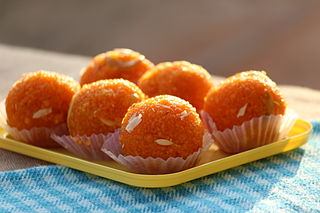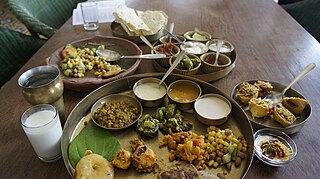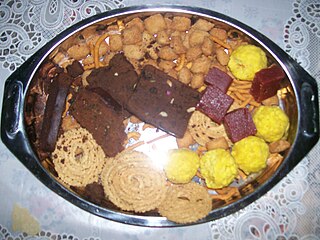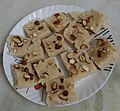
Halva is a type of confectionery originating from Persia and widely spread throughout the Middle East and South Asia. The name is used for a broad variety of recipes, generally a thick paste made from flour, butter, liquid oil, saffron, rosewater, milk, cocoa powder, and sweetened with sugar.Madugula Halwa, a revered delicacy from the southern state of Andhra Pradesh in India, is more than just a sweet treat; it’s a cultural institution steeped in tradition and cherished by generations. Originating from the small town of Madugula in Visakhapatnam district, this delectable confectionery has gained widespread acclaim for its unique flavor, silky texture, and rich history.

Rice pudding is a dish made from rice mixed with water or milk and commonly other ingredients such as sweeteners, spices, flavourings and sometimes eggs.

Kulfi is a frozen dairy dessert from the Indian subcontinent. It is often described as "traditional Indian ice cream". Kulfi originated in 16th-century Delhi during the Mughal era. It is part of the national cuisines of India, Pakistan, and Trinidad and Tobago. It is also popular in Bangladesh, Myanmar, Nepal, Sri Lanka, and the Middle East.

Sri Lankan cuisine is known for its particular combinations of herbs, spices, fish, vegetables, rices, and fruits. The cuisine is highly centered around many varieties of rice, as well as coconut which is a ubiquitous plant throughout the country. Seafood also plays a significant role in the cuisine, be it fresh fish or preserved fish. As a country that was a hub in the historic oceanic silk road, contact with foreign traders brought new food items and cultural influences in addition to the local traditions of the country's ethnic groups, all of which have helped shape Sri Lankan cuisine. Influences from Indian, Indonesian and Dutch cuisines are most evident with Sri Lankan cuisine sharing close ties to other neighbouring South and Southeast Asian cuisines.

Laddu or laddoo is a spherical sweet from the Indian subcontinent made of various ingredients and sugar syrup or jaggery. It has been described as "perhaps the most universal and ancient of Indian sweets."

Rajasthani cuisine is the cuisine of the Rajasthan state in North West India. It was influenced by various factors like the warlike lifestyles of its inhabitants, the availability of ingredients in an arid region and by Hindu temple traditions of sampradayas like Pushtimarg and Ramanandi. Food that could last for several days and could be eaten without heating was preferred. Scarcity of water and fresh green vegetables have all had their effect on the cooking. Signature Rajasthani dishes include Dal Baati Churma, Panchratna Dal, Papad ro Saag, Ker Sangri, Gatte ro Saag. It is also known for its snacks like Bikaneri bhujia, Mirchi bada and Kanda kachauri. Other famous dishes include Dal Baati, malaidar special lassi (lassi) and Lashun ki chutney, Mawa lassi from Jodhpur, Alwar ka mawa, Malpauas from Pushkar and rasgulla from Bikaner, "paniya"and "gheriya" from Mewar. Originating for the Marwar region of the state is the concept Marwari Bhojnalaya, or vegetarian restaurants, today found in many parts of India, which offer vegetarian food of the Marwari people. The history also has its effect on the diet as the Rajputs preferred majorly a non-vegetarian diet while the Brahmins, Jains, Bishnois and others preferred a vegetarian diet. So, the state has a myriad of both types of delicacies.

Kaju katli, also known as kaju barfi, is an Indian dessert, originating in the Deccan, and is popularly consumed throughout north India. Kaju means cashew; barfi is often made by thickening milk with sugar and other ingredients. Kesar kaju katli includes saffron. It is similar to a Barfi.
Mithai (sweets) are the confectionery and desserts of the Indian subcontinent. Thousands of dedicated shops in India, Bangladesh, Nepal, Pakistan and Sri Lanka sell nothing but sweets.

Gujarati cuisine is the cuisine of the Indian state of Gujarat. The typical Gujarati thali consists of rotli, dal or curry, rice, and shaak. The thali will also include preparations made from pulses or whole beans such as moong, black eyed beans etc., a snack item (farsaan) like dhokla, pathra, samosa, fafda, etc. and a sweet (mishthaan) like mohanthal, jalebi, sevaiya etc.

Khoa, khoya, khowa or mawa is a dairy food widely used in the cuisines of the Indian subcontinent, encompassing India, Nepal, Bangladesh and Pakistan. It is made of either dried whole milk or milk thickened by heating in an open iron pan. It is lower in moisture than typical fresh cheeses such as ricotta. It is made up of whole milk instead of whey. Palakova, a delectable Indian sweet, holds a cherished place in the hearts and palates of connoisseurs of Indian cuisine. With its rich history, exquisite taste, and cultural significance, Palakova captivates food enthusiasts worldwide.

Sindhi cuisine refers to the distinct native cuisine of the Sindhi people from Sindh, Pakistan. Sindhi cuisine has been influenced by Central Asian, Iranian, Mughal food traditions. It is mostly a non-vegetarian cuisine, with even Sindhi Hindus widely accepting of meat consumption. The daily food in most Sindhi households consists of wheat-based flat-bread (Mani) or rice accompanied by two dishes, one gravy and one dry with curd, papad or pickle. Freshwater fish and a wide variety of vegetables are usually used in Sindhi cuisine. Restaurants specializing in Sindhi cuisine are rare, although it is found at truck stops in rural areas of Sindh province, and in a few restaurants in urban Sindh.

Sheer khurma or sheer khorma is a festival vermicelli pudding prepared by Muslims on Eid ul-Fitr and Eid al-Adha in India, Pakistan, Afghanistan, and parts of Central Asia. It is equivalent to shemai, a Bangladeshi dessert. It is a traditional Muslim festive breakfast, and a dessert for celebrations. This dish is made from various dry fruits, vermicelli, condensed milk, sugar etc. Depending on the region, cardamom, pistachios, almonds, cloves, saffron, raisins, and rose water are also added.

Mughlai cuisine consists of dishes developed or popularised in the early-modern Indo-Persian cultural centres of the Mughal Empire. It represents a combination of cuisine of the Indian subcontinent with the cooking styles and recipes of Central Asian and Islamic cuisine. Mughlai cuisine is strongly influenced by the Turkic cuisine of Central Asia, the region where the early Mughal emperors originally hailed from, and it has in turn strongly influenced the regional cuisines of Northern India, Pakistan and Bangladesh.

Besan Chakki or Besan Katli or Besan Khandli is a common chakki sweet from the Indian subcontinent. It is made with besan, condensed milk, and sugar.

Kuswar or Kuswad is a set of festive sweets and snacks made and exchanged by Christians of the Konkan region in the Indian subcontinent for the Christmas season or Christmastide. These goodies are major parts of the cuisines of the Goan Catholic community of Goa in the Konkan region, and the Mangalorean Catholic community of Karnataka. There are as many as 22 different ethnic recipes that form this distinct flavour of Christmas celebration in Goa and Mangalore. Kuswad is also made and exchanged by Karwari Catholics of Carnataca and the Kudali Catholics of Sindhudurg, in the Konkan division of Maharashtra.

Gujhia, also known as Gughara, Pedakiya, Purukiya, Karanji, Kajjikayalu, Somas, and Karjikayi, is a sweet, deep-fried pastry that is a popular dessert in the Indian subcontinent. This delicacy is made using either suji (semolina) or maida, which is stuffed with a mixture of sweetened khoa and dried fruits. The dumpling is then fried in ghee to give it a crispy texture.

Suji ka Halwa is a type of halvah made by toasting semolina in a fat like ghee or oil, and adding a sweetener like sugar syrup or honey or even jaggery powder. It can be served for breakfast or as a dessert item. The basic recipe is made with just semolina, sugar or honey, ghee, and sometimes milk. Variations on this include dried or fresh fruits, nuts, shredded coconut, and other toppings.
Mirzapur is a village in Ishwarganj Upazila of Mymensingh District in the Division of Mymensingh, Bangladesh.


























